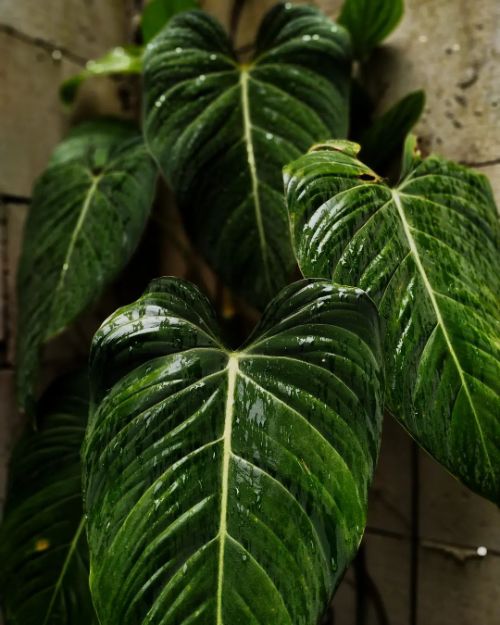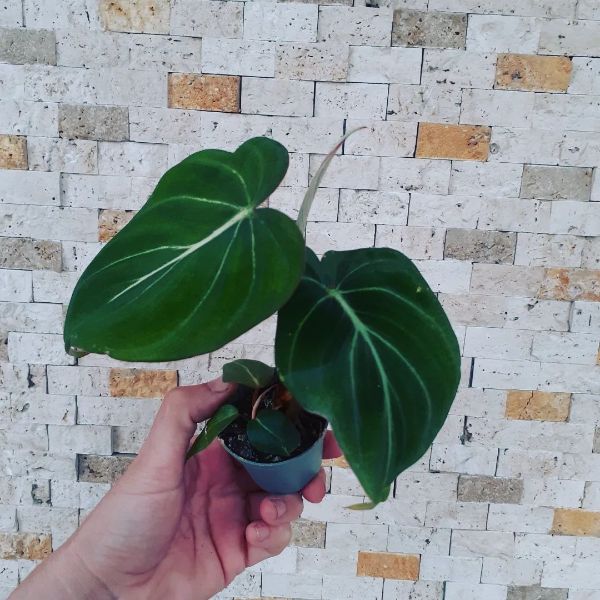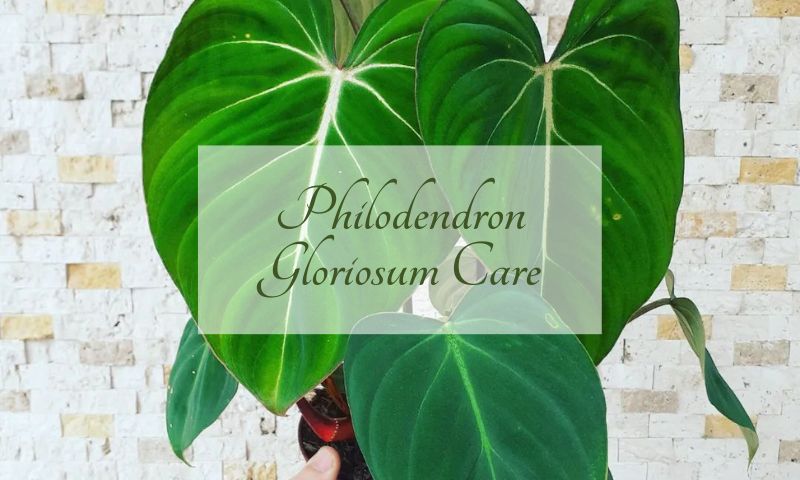One of the most striking species of plants in the tropical rainforest is philodendron gloriosum. With its deep green leaves and distinctive lobed shape, it’s no surprise that lots of people want to grow this amazing plant just for fun. The good news is that Philodendron Gloriosum care does not require much effort – as long as you understand the basics! In this ultimate guide on how to care for and grow your very own Philodendron Gloriosum, we will explore everything from ideal conditions to tasty snacks your precious plant might enjoy. So don’t delay any further- let’s get planting!
Philodendron Gloriosum care overview
| Botanical Name | Philodendron gloriosum |
| Common Name | Philodendron gloriosum |
| Family | Araceae |
| Genus | Philodendron |
| Mature Size | Up to 2.5 feet tall |
| Soil Type | Well-drained |
| Soil pH | Acidic, Neutral |
| Native Area | South America |
| Temperature | 65 to 75°F |
| Light | Bright, indirect light |
| Watering | Moderate |
| Humidity | 60-80% |
| Fertilizer | Fertilize 1 times per month |
| Propagation | Stem cuttings |
| Toxicity | Toxic to humans and toxic to pets when ingested |
How to care for Philodendron Gloriosum?
Looking after Philodendron Gloriosum is rewarding but can be a bit tricky since it’s a super delicate plant. To make sure your Philodendron Gloriosum stays healthy and colorful all year, you’ve got to give it the right amount of sunlight, water, and fertilizer.
Light Requirements
Philodendron gloriosum is a beautiful tropical plant with large, velvety leaves and striking white veins. To help your Philodendron gloriosum thrive, it’s important to provide the right light conditions.
Here are the light requirements for Philodendron gloriosum:
- Indirect sunlight: Philodendron gloriosum likes bright, indirect sunlight. Direct sunlight can burn the leaves, while too little light makes it grow weird and have small leaves. Put your plant near a window with shaded light or a bit away from a sunny window.
- East or North-facing window: An east or north-facing window is usually perfect for Philodendron gloriosum, since these windows have softer sunlight. If you only have south or west-facing windows, you can make it work with light curtains or blinds.
- Artificial light: If you don’t have a window with the right light, you can grow your Philodendron gloriosum with fake light. Fluorescent or LED growing lights will work for your plant. Just put the grow light about 1-2 feet above the plant and leave it on for 12-14 hours each day.
- Adjusting light conditions: Watch how your Philodendron gloriosum grows and change the light as needed. If the leaves look pale or the plant leans toward the light, it might need more. If the leaves get brown or burned spots, it might be getting too much direct sun.
By giving your Philodendron gloriosum the right light, you’ll get bright, healthy leaves and steady growth.

Soil
Philodendron gloriosum requires well-draining, nutrient-rich soil to thrive. The best soil should hold some water but not get soggy since the plant can’t handle too much water and might rot. Here’s a simple soil mix for your Philodendron gloriosum:
Basic mix:
- 2 parts peat moss or coco coir
- 1 part perlite or pumice
- 1 part orchid bark or aged pine bark
This mix provides a balance of moisture retention, aeration, and drainage, which is super important for the plant’s root health.
Optional additives: You can also add other components to enhance the soil mix further, such as:
- Horticultural charcoal: This can help improve drainage and prevent the buildup of harmful substances in the soil.
- Worm castings or well-composted manure: These organic materials provide additional nutrients for your plant.
Potting and drainage: When putting your Philodendron gloriosum in a pot, pick one with holes in the bottom to keep water from building up, which can cause rot. You might also want to put some gravel, perlite, or LECA at the bottom to help with draining.
Soil pH: Philodendron gloriosum likes slightly sour to plain soil, with a pH from 6.0 to 7.0. You can check the pH with a soil tester and change it with stuff like limestone or sulfur if you need to.
By providing the right soil mix for your Philodendron gloriosum, you’ll create an environment that promotes healthy root growth, better water management, and overall plant well-being.
Watering
Getting the watering right for your Philodendron Gloriosum is a big deal if you want it to stay healthy. Only water it when the soil feels dry, up to halfway into the pot. Make sure to water it well until you see water coming out the bottom, and then toss any leftover water into the sink or a bucket. You’ll want to water it 1-2 times a week when it’s growing, and cut back in winter when things slow down. Watering too frequently or not enough can both cause problems for the plant, so make sure to keep a close eye on your Philodendron Gloriosum and adjust your watering schedule as needed.

Make sure to use rainwater, distilled water, or tap water that’s been sitting out overnight, since straight from the tap might have stuff like chlorine that could hurt your plant. Water in the morning so extra moisture can dry up before night comes. If you are unsure if or when to water your Philodendron Gloriosum, just remember: stick your finger into the pot and see if the half topsoil is dry. Watering your plant at this point will ensure that it stays healthy and happy!
Temperature
Since the Philodendron gloriosum likes the tropics, it’s all about warm, steady temps. Actually, having the right temperature around your plant is key to keeping it healthy and thriving.
The optimal temperature range for Philodendron gloriosum is between 65°F (18°C) to 80°F (27°C). The plant can withstand little swings, but it must not be subjected to high temperatures or abrupt shifts as this could stress and harm the plant.
To keep your Philodendron gloriosum at the correct temperature, keep the following in mind:
- Positioning: In the cold months, keep it away from drafty spots like AC vents, open windows, or doors. And stay away from stuff that heats like radiators, stoves, or heaters since that could make it too hot.
- Nighttime temperature drop: Philodendron gloriosum can take a bit of a chill at night, but don’t let it get under 60°F (16°C) for too long, or it could slow down or even get damaged.
- Outdoor growing: If your Philodendron gloriosum is outdoors, keep an eye on the local weather, and bring it in or cover it up if it gets too cold or frosty.
Stick to a steady temperature between 65°F and 80°F, and you’ll make your Philodendron gloriosum feel right at home, with healthy growth and bright leaves.
Humidity
Humidity is a key factor to consider when taking care of your Philodendron Gloriosum. Humidity levels should generally stay around 40-70% at minimum and ideally up to 80%. Keeping the humidity up will help keep the plant’s leaves looking and feeling their best. Mist your Gloriosum regularly, similar to how you would give yourself a facial spa. If the environment humidity is below 40%, make use of an indoor humidifier to help bring it back up to the optimal levels for your Philodendron Gloriosum.
Fertilizer
Feeding your Philodendron gloriosum with the right fertilizer will help promote healthy growth and maintain its lush foliage. Here’s what you need to know about fertilizing your Philodendron gloriosum:
- Type of fertilizer: Grab a balanced, water-mixable plant food with equal parts nitrogen (N), phosphorus (P), and potassium (K). Think 20-20-20 or 10-10-10. It’ll give your Philodendron gloriosum just what it needs to grow best.
- Dilution: Cut the food strength in half from what the box says to avoid overdoing it. Too much could mess up the leaves or the roots.
- Frequency: Feed your plant every 4 to 6 weeks when it’s growing (that’s spring and summer). In the fall and winter, cut back to every 8 to 10 weeks or just quit since the plant won’t be growing much.
- Application: Apply the diluted fertilizer solution while watering your plant, ensuring that the soil is evenly moistened. Be careful not to splash the fertilizer on the leaves, as this can cause damage.
- Monitoring: Watch how your plant’s doing to see if you’re feeding it just right. If the leaves turn yellow or look burnt, or if the plant looks weak, cut back on the food. But if it looks pale or unhealthy, you might need to feed it a bit more.
By giving it the right food and sticking to a schedule, your Philodendron gloriosum will stay bright and healthy. Always tweak the food routine to suit your plant and where you live.
Repotting
Repotting your Philodendron Gloriosum is essential for its long-term health and growth. Repotting the plant should be done when it has outgrown its current container – this can be identified by examining the roots of the plant, which will have filled up the pot to the point where they cannot expand any further. Repotting will give the Philodendron Gloriosum more room to grow and develop, as well as more access to nutrients from the soil.
When you repot, pick a pot that’s 1-2 inches bigger. Best time to do this is in late spring or early summer. Be gentle when you take it out, pop it in the new pot with fresh soil, and give it a good drink. Put it where it’ll get lots of indirect sun. Repotting like this will make the roots healthy and the leaves big and shiny.

When repotting your Philodendron Gloriosum, it’s important to choose a container that’s 1-2 inches larger than its current pot. Repotting should be done in late spring or early summer, and should be done carefully. Gently loosen the root system and remove the plant from its current pot before transferring it to its new container filled with fresh soil. Water well after repotting and place the Philodendron Gloriosum in a spot that provides plenty of indirect sunlight. Repotting your Philodendron Gloriosum will help it grow and develop healthy roots, as well as big, glossy leaves.
Pruning
Trimming your Philodendron gloriosum is easy but super important. It helps new growth, gets rid of ugly or dead leaves, and keeps the plant from getting too big. Do it every six months for top results. When you’re cutting, use clean, sharp tools and don’t go too deep. Get all the dead stuff off, and only cut back the healthy bits if you need to.
Related: Philodendron Micans Care And Grow: The Ultimate Guide
Philodendron Gloriosum Propagation
Making more Philodendron Gloriosum usually happens by snipping the stem.
- Propagate in the spring and summer when the plant’s growing like crazy.
- Grab a piece of stem that’s at least 6 inches long and strip all the leaves off the bottom half.
- Place this cutting into moist, well-draining soil or rooting medium.
- Make sure you use a pot that lets the water out.
- Put the snipped part somewhere with bright but not direct light, and keep the soil damp but not all mushy.
- It might take as long as 6 weeks for roots to show up, and then you can move it into its forever pot.
You can also make more Philodendron Gloriosum by division, although it is a more complex and time-consuming method. Make sure to gently tease away the roots and separate them into multiple sections before repotting. When propagating Philodendron Gloriosum in this way, make sure you provide each section with adequate space so they can grow properly.

Gloriosum Philodendron Common Pests & Plant Diseases
Gloriosum Philodendron is a gorgeous and no-fuss houseplant. Even though it’s usually healthy, there might be some bugs and diseases that can give you trouble. Usual pests of Gloriosum Philodendron include stuff like aphids, mealybugs, scale insects, mites, and whiteflies. Besides pests, some diseases can hit Gloriosum Philodendron, like bacterial leaf spot, root rot, and fungal crown rot.
To keep pests at bay, just keep the plant clean by getting rid of dead leaves, don’t water it too much, and make sure there’s enough air moving around the plant. If you find bugs on the plant, move fast so they don’t cause too much harm. You can use bug spray to treat the pests, but natural stuff like insecticidal soap or neem oil usually works better and doesn’t hurt the plant.
When it comes to keeping disease away, only water when you need to and don’t let the soil get all soggy. If the leaves start turning yellow, brown, or black, check the plant for signs of sickness. If you find anything, cut out the bad parts and get rid of any dead stuff. You can use bug spray for fungus, but it’s smarter to talk to a pro before using it on your Gloriosum Philodendron.
Philodendron Gloriosum Care Common Problems
Taking care of Philodendron gloriosum is usually a breeze, but like other indoor plants, sometimes things go wrong. Catching and fixing these problems early is key to keeping your plant happy. Here’s what might go wrong and how to fix it:
- Yellowing leaves: Too much water is often why leaves turn yellow on Philodendron gloriosum. Check how wet the soil is and change how you water it if needed. Make sure the soil drains well, and the pot has holes so the water doesn’t get stuck.
- Brown leaf tips or edges: This could be because of not enough water, dry air, or too much plant food. Make sure the soil stays a bit damp (but not all wet), up the moisture around the plant, and cut the plant food down to half what it says on the box.
- Leggy growth and small leaves: Not enough light can make the plant grow all stretched out and the leaves get small. Move your plant to a place with more light but not direct sun, or think about adding some fake light.
- Pests: The usual bugs that mess with Philodendron gloriosum are spider mites, mealybugs, and scale insects. Look at the plant often for creepy crawlies. If you find any, get on it quick with insecticidal soap, neem oil, or the right bug spray, just like it says on the bottle.
- Root rot: Too much water or soil that doesn’t drain can cause root rot. If you think your plant’s got root rot, take it out of the pot, cut off the bad roots, and put it in new, draining soil. Change how you water it so it doesn’t happen again.
- Leaf curling or wrinkling: This might be a sign of not enough water or dry air. Make sure your plant’s getting enough water, and think about adding moisture by putting it on a wet tray, spraying the leaves, or using a machine that makes mist.
By taking care of these usual problems and looking after your plant right, you can keep your Philodendron gloriosum looking good and healthy. Keep an eye on how your plant’s doing and change what you’re doing if you need to, so you stop problems before they start or fix them quick.
FAQ about Philodendron Gloriosum care
Is Philodendron Gloriosum easy to care for?
Yes, caring for Philodendron Gloriosum is pretty simple. It likes bright but not direct light, normal household humidity, and soil that drains well but stays a bit damp. Water it when the top 2 to 3 inches of soil feel dry. Fertilizer’s fine during the growing months (April to September) but not a must. It’s a good idea to wipe the leaves now and then with a damp cloth to keep the plant looking good.
Should I mist my Philodendron Gloriosum?
Mist your Gloriosum to keep the leaves moist, but you don’t have to. You can spray it once or twice a week if your home’s air is dry.
Is Philodendron Gloriosum fast growing?
Philodendron Gloriosum is more of a slowpoke. It can take a long time before it starts popping out new leaves.
How can I make my Philodendron Gloriosum grow faster?
Want your Philodendron Gloriosum to grow faster? Give it plenty of light, keep the soil damp but not soggy, and feed it now and then during the growing season. You can also try snipping new growth at the base of the stem to make it branch out more. Cutting back dead or yellow leaves and overly long stems can help new growth along too.
The Philodendron Gloriosum is a real eye-catcher and will jazz up any room or garden. They’re pretty easy to look after as long as you get the light, soil, water, temperature, and humidity right. Remember to feed and repot your plant when needed and give it a trim now and then. Run into any bugs or sickly spots? There’s loads of common fixes that should sort things out. With this guide, you’re all set to look after your very own Philodendron Gloriosum. For more information about other types of Philodendrons, be sure to visit Famiplants.

